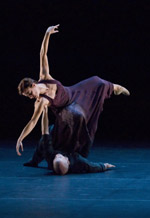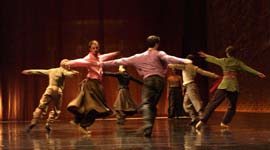
Jack Anderson
Three European Contemporaries
Danskdanseteater
Joyce SoHo, 155 Mercer Street, SoHo
Oct. 11-13, 2007 (closed)
Information: (212) 691-9740
Compañía Nacional de Danza
BAM Howard Gilman Opera House, 30 Lafayette Avenue, Fort Greene, Brooklyn
Oct. 16, 18-20, 2007 (closed)
Information: (718) 636-4129
Ballet du Grand Théâtre de Genève
Joyce Theater, 175 Eighth Avenue at 19th Street, Chelsea
Oct. 23-28, 2007 (closed)
Information: (212) 242-0800
Reviewed by Jack Anderson, Oct. 29, 2007
There's an increasingly common theatrical dance form: not really ballet,
at least ballet in the strictest classical sense, for it may incorporate
modern dance steps, yet not pure modern dance, for its choreographers
may require performers with ballet training, even though they may not
have to dance on pointe. Call it contemporary dance, perhaps. Whatever
it's called, it's everywhere, especially in Europe, and three notable
companies specializing in it visited New York recently: one from Switzerland
(Ballet du Grand Théâtre de Genève), one from Spain
(Compañía Nacional de Danza), and one from Denmark (Danskdansetheater).
They were similar in several ways. Their presentations successfully fused classical and modern techniques. Their dancers were well-trained and good-looking, although few appeared to have distinctive stage personalities. (But that could be said about some dancers in American groups nowadays.) All three companies tended to be internationalist, rather than local in their artistic vision. There was nothing distinctively Swiss about the Swiss, nothing unmistakably Spanish about the Spaniards or Danish about the Danes. In fact, there is not a single Danish-born dancer in Danskdanseteater this season, and Tim Rushton, its director-choreographer, is British. Gerd Schottländer, its dramaturge, told me that this not because the administration scorns Danish dancers, but because Rushton seeks dancers of "a certain intensity," and at this moment available dancers from other nations seemed more suitable.
 |
| Compania Nacional de Danza -- Yolanda Martin and Dimo Kirilov. Photo by Tom Brazil. |
During an intermission at a performance by the Spaniards, an acquaintance I met in the lobby expressed disappointment that the program included no flamenco. When I reminded her that this was a ballet-and-modern-dance group, she said she still wished there had been at least a little flamenco. The Spaniards wisely refuse to be bound by stereotyped notions of their dance culture, and flamenco, of course, is not the only indigenous Spanish dance form. Still, it does seem odd that choreographers for troupes like these do not make more attempts to investigate their countries' history, folklore, or urban and rural life-styles. But similar complaints can be raised against many American groups. Choreographers should certainly refrain from wallowing in folkloric corn. Nevertheless, it still seems odd that you can go almost anywhere nowadays and see ballets about Cinderella or Romeo and Juliet, but how often do you see a ballet about the Great Plains, New England, or the Deep South?
The visiting European companies differed considerably in organization from their American counterparts. Despite some funding from national and state arts agencies and philanthropic foundations, American companies lead a precarious existence, whereas the Europeans are much more heavily subsidized by municipal, regional, or national governments. Moreover, European companies may be firmly attached to a home-theater, as the Geneva company is. Company directors and dancers may come and go, but organizational structures usually remain secure.
 |
Ballet
du Grand Théâtre de Genève |
Therefore glancing over any group's history may reveal unexpected oddities. For instance, whereas the present Geneva company is rooted in today's contemporary fusion idiom, when I first visited Geneva in the early 1970's, it was a vigorous exponent of Balanchine, under Alfonso Catá's direction. The Spaniards' current director, Nacho Duato, has been strongly influenced by the contemporary style of Netherlands Dance Theater. Yet one of his directorial predecessors was Maya Plisetskaya.
In their present incarnations, these visiting companies appear to be thriving. The biggest surprise was the group from Geneva, where the theater's general director is Jean-Marie Blanchard and the current ballet director is Philippe Cohen. They brought New Yorkers ballets by three choreographers essentially unknown here (none of them Swiss, incidentally), and who surely deserve to be better known.
"Para-Dice," by Saburo Teshigawara, of Japan, set four couples swinging their arms energetically to a sound score by Willi Bopp, and these eye-catching sequences were juxtaposed with looser sinkings to the floor.
The Belgian-born Sidi Larbi Cherkaoui, who contributed "Loin" to 17th-century music by Biber, had his ensemble move briskly and, at the conclusion, form a human pyramid. But dancers occasionally interrupted such exertions to step forward in a line and, in moments recalling similar passages in productions by Pina Bausch, address the audience, talking in this case about touring problems, including the indignity of sharing a stage in China with rats and cockroaches. "Loin" therefore glorified the art of dance while sighing over the vicissitudes of a dancer's life.
One of the oddities of the costumes by Isabelle Lhoas, in collaboration with Frédéric Denis, was the fact that some of the men wore skirts for no obvious reason relating to any themes of gender or sexual role-playing. So, too, in "Selon Désir," both choreographed and costumed by Andonis Foniadakis, of Greece, men and women alike wore skirts while plunging across the stage to the opening choruses of both the St. Matthew and the St. John Passions of Bach, heard first in an electronic distortion by Julien Tarride and then in their full Baroque glory. Although the mounting excitement was breathtaking, there seemed no obvious reason (at least no sexual-political reason) for male skirts. Yet the way the folds of everyone's skirts flapped while the dancers moved intensified the choreographic boldness. Who knows? Perhaps skirts for men may possess previously unsuspected esthetic possibilities worthy of further investigation.
Nacho Duato, of the Spanish troupe, is the visiting choreographer best-known here. In addition to being able to create torrents of inventive movement, Duato has a strong dramatic sense, and he has ideas, intellectual as well as choreographic. But, despite impressive moments, his works at BAM did not always express ideas and feelings as clearly as they might have. In "Por Vos Muero," to 15th and 16th -century Spanish music and the recitation of a melancholy love poem by Garcilaso de la Vega ("for thee I was born, / for thee I am alive / for thee I have to die, / and for thee I die"), Duato suggested contrasts between formal restraint and spontaneous emotional outpouring.
The all-male cast of "Castrati" hurtled wildly to Vivaldi, and one lad was captured and presumably emasculated to serve as a castrato singer. Convulsive movements dominated "White Darkness," to Karl Jenkins, and white dust occasionally rained down upon individuals. A note in press releases revealed that Duato's sister died of drug addiction, so one could guess what the dust signified. But without reading the note, would one have really known that? Sometimes, surely, dust is just dust. Duato at times appears to want to tell stories. But he may be hampered in his attempts by a feeling prevalent in parts of the dance world that story-telling is no longer "in," or, if it is attempted at all, it can only be done in the most literal manner. Duato, who can devise imaginative steps, should also be enterprising enough to experiment with narrative.
Tim Rushton, of the Danes, is best known here for the Bach caprices he has created as divertissements for Danish ballet dancers. His own group offered another Bach piece, "Bach Suites: a dancing homage to Bach," his only work performed in its entirety. The rest of the evening was devoted to excerpts from other Rushton creations, quite turbulent ones from the look of them. This decision to show excerpts was surely made to provide audiences with samples of his choreography.
But it may have been unwise. Each snippet was strongly emotional, but because there was no context, all emotions seemed to arise from no discernible source and then lead nowhere. Yet there were many strong effects. Dancers' positions were outlined in chalk in "Kridt," the images reminiscent of the ones police officers draw to indicate fallen bodies at crime scenes. Dancers kept linking and separating with almost unnerving energy in "Silent Steps." And the encounters in "Animal Park" looked violent, even when no one actually touched.
Rushton's bits were like movie previews of coming attractions, whetting the appetite without satisfying it. But, of course, they weren't meant to.
All three companies provided intriguing glimpses of unfamiliar repertories. What we saw was eminently serious, making those dancegoers who love to call anything European they disdain "Eurotrash" sound pettily xenophobic. In retaliation, I wish European audiences unhappy with American dances would pronounce them "Yankeejunk."
No, on second thought, I don't wish that. Instead, I hope
that civility can prevail in international artistic affairs, even though
it rarely does in international politics.
| museums | NYTW mail | recordings | coupons | publications | classified |
